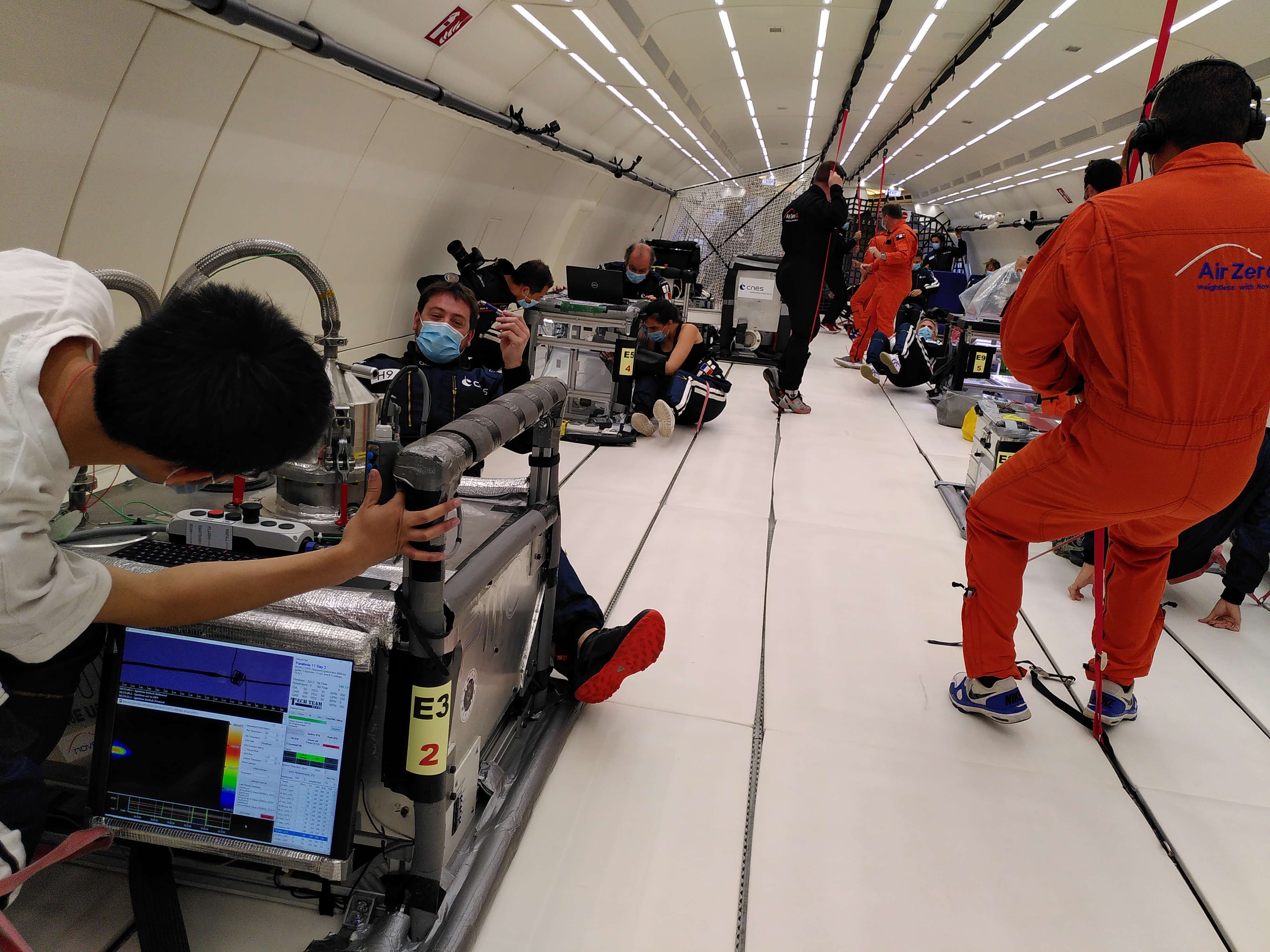- Détails
- Écrit par legros
- Catégorie : Articles exemples
- Affichages : 3271
On this page, you will find the latest proposals to work with us.
Internships 2025 at Inst. d'Alembert:
Internships 2025 at New York Univ.:
- Détails
- Écrit par legros
- Catégorie : Articles exemples
- Affichages : 4426
Follow here the studies that aim at the quantification of the soot production by alternatives fuels.
Recent related publications:
M. Kashif, J. Bonnety, P. Guibert, C. Morin, and G. Legros. Soot volume fraction fields in unsteady axis-symmetric flames by continuous laser extinction technique. Optics Express, 20:28742–28751, 2012 [link].
M. Kashif, J. Bonnety, P. Guibert, and G. Legros. Sooting tendencies of primary reference fuels in atmospheric laminar diffusion flames burning into vitiated air. Combustion & Flame, 161:1575–1586, 2014 [link].
J.-L. Consalvi, F. Liu, J. Contreras, M. Kashif, G. Legros, S. Shuai, and J. Wang. Numerical study of soot formation in laminar coflow diffusion flames of methane doped with primary reference fuels. Combustion & Flame, 162:1153–1163, 2015 [link].
M. Kashif, J. Bonnety, A. Matynia, P. Da Costa, and G. Legros. Sooting propensities of some gasoline surrogate fuels: combined effects of fuel blending and air vitiation. Combustion & Flame, 162:1840–1847, 2015 [link].
G. Legros, Q. Wang, J. Bonnety, M. Kashif, C. Morin, J.-L. Consalvi, and F. Liu. Simultaneous soot temperature and volume fraction measurements in axis-symmetric flames by a two-dimensional modulated absorption/emission technique. Combustion & Flame, 162:2705–2719, 2015 [link].
J. Abboud, J. Schobing, G. Legros, J. Bonnety, V. Tschamber, A. Brillard, G. Leyssens, V. Lauga, E.E. Iojoiu, and P. Da Costa. Impacts of oxygenated compounds concentration on sooting propensities and soot oxidative reactivity: Application to Diesel and Biodiesel surrogates Fuel, 193:241-253, 2017 [link].
J.-L. Consalvi, F. Liu, M. Kashif, and G. Legros. Numerical study of soot formation in laminar coflow methane/air diffusion flames doped by n-heptane/toluene and iso-octane/toluene blends. Combustion & Flame, 180:167-174, 2017 [link].
J. Abboud, J. Schobing, G. Legros, A. Matynia, J. Bonnety, V. Tschamber, A. Brillard, G. Leyssens, P. Da Costa. Impacts of ester's carbon chain length and concentration on sooting propensities and soot oxidative reactivity: Application to Diesel and Biodiesel surrogates Fuel, 222:586-598, 2018 [link].
H. Zhang, O. Pereira, G. Legros, E.E. Iojoiu, M.E. Galvez, Y. Chen, P. Da Costa. Structure-reactivity study of model and Biodiesel soot in model DPF regeneration conditions. Fuel, 239:373-386, 2019. [link].
J. Bonnety, A. Guibaud, R. Jalain, A. Matynia, J.-L. Consalvi, F. Liu, G. Legros. Probing the local radiative quenching during the transition from a non-smoking to a smoking laminar coflow ethylene/air non-premixed flame. Combustion & Flame, 203:120-129, 2019 [link].
Rationales
The growing concerns about increasing energy demand, energy efficiency policies, energy security issues, hazardous effects of combustion-related emissions on human health, and global warming change have led to more and more stringent regulations on exhaust emissions from combustion devices, and especially on soot release.
The recent legislation and guidelines to mitigate emissions related problems prescribe the integration of renewable fuels into the transportation fuel pool and the use of high-efficiency combustion devices to reduce CO2 emissions. These challenges can be converted into opportunities through a careful selection of renewable/alternative fuel compositions and efficient advanced combustion processes.
Alternative and biofuels exhibit a wide range of combustion characteristics and induce different effects on combustion processes, and therefore ultimately on exhaust emissions. Hence, mixtures composed of alternative fuels could be designed specifically to comply with a set of requirements, for instance, to reduce soot.
Works at ∂'Alembert
The concept that drives our works is the Yield Sooting Index (YSI) that McEnally and Pfefferle suggested in the 2000s. This standard test intends to evaluate the sooting tendency of any fuel. This procedure is the first one to infer the index from direct measurement of soot concentration, called soot volume fraction. Measuring the peak soot volume fraction fv,max in a flame established in standardized conditions indeed allows the YSI of the burning fuel to be inferred as follows:
![]()
The schematic below introduces the experimental setup that has been developed at Inst. ∂'Alembert to allow the standardized conditions to be established, therefore the YSIs to be measured. Upstream the burner above which the flame is established, a specific setup has been designed to evaporate the liquid fuel whose sooting tendency is to be evaluated. The vapors are then mixed to a carrier gas, i.e. a mixture composed of methane and nitrogen. In the absence of vapors, the flame established over the burner hardly produces soot. As a result, in the presence of vapors, the sooting tendency is attributed to the liquid fuel that has been vaporized.
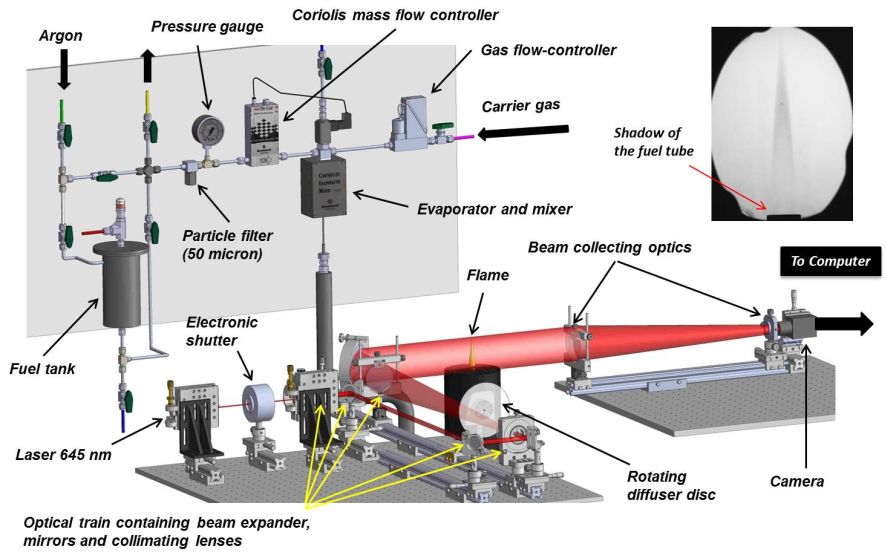
Figure 1: experimental arrangement for the measurement of the Yield Sooting Index of the liquid fuel filling the fuel tank. The insert in the upper right corner shows a typical frame recorded by the camera that captures the absorption of the laser beam crossing the flame.
Within the context of these works, the soot volume fraction field is mapped by the measurement of the absorption of a laser beam that crosses the flame. With a wise selection of the operating laser wavelength, this absorption of the light can be attributed to soot particles. Then some theoretical considerations allow the soot volume fraction to be inferred from the absorption field measured over the sensor of a camera (see the conical soot layer absorbing the laser light over the burner tip in the insert shown in Fig.1).
Figure 2 illustrates how the composition of a fuel blend can influence the sooting tendency. Here, toluene is blended with either n-heptane or isooctane. These kinds of blends are considered as commercial gasoline surrogates. XTol. is toluene mole fraction in the blend. Figure 2 also shows the mitigation of YSI, i.e. soot production, when CO2 is added to the oxidizer (air), XCO2 being the CO2 mole fraction in this oxidizer. This represents an assessment of the effect of Exhaust Gas Recirculation (EGR) on particulate matter emission by Internal Combustion engines.
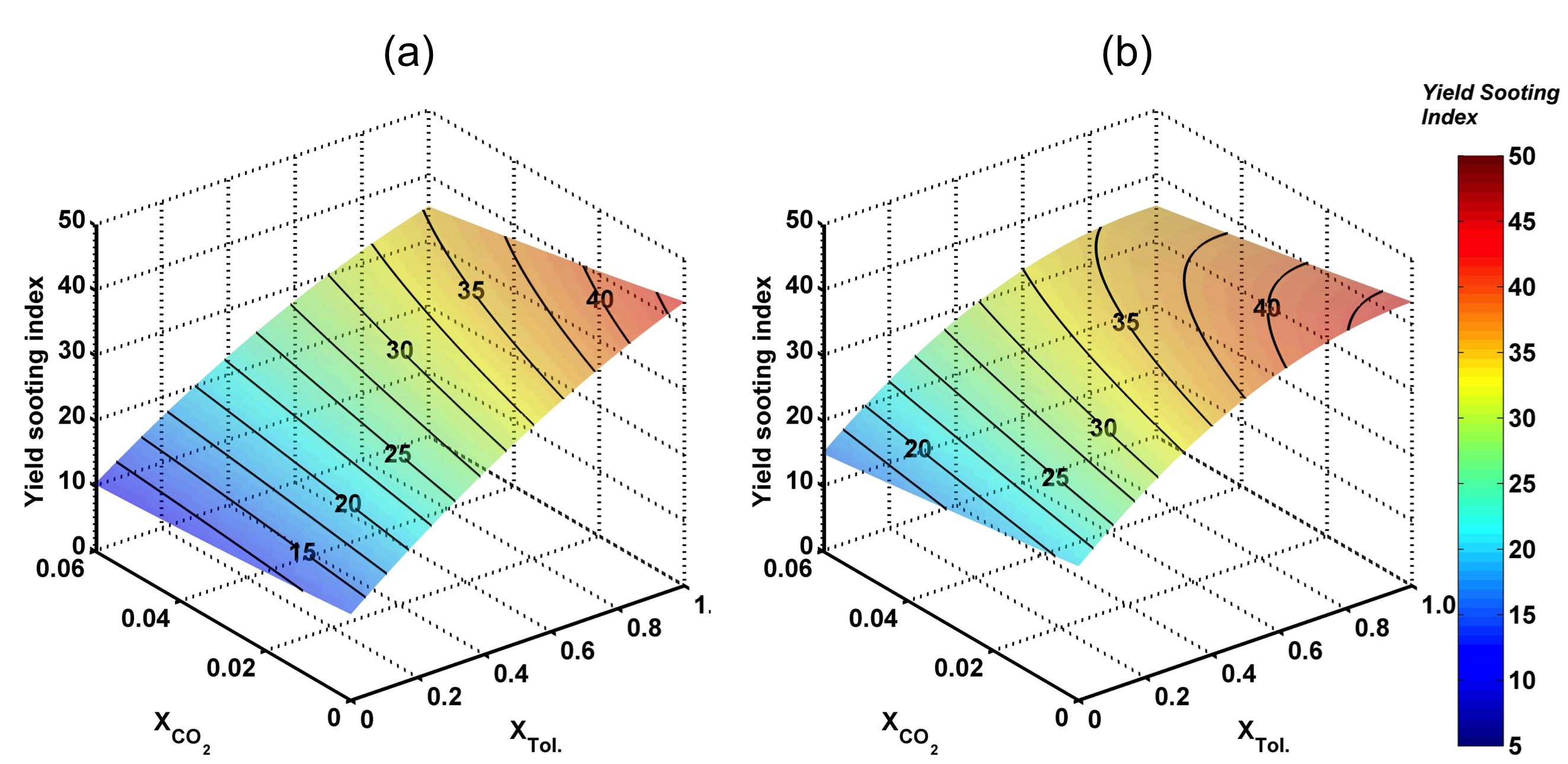
Figure 2: surfaces modeling the evolution of YSI as a function of CO2 mole fraction (XCO2) in the coflowing air and toluene mole fraction (XTol.) in the blends of: (a) n-heptane/toluene; (b) isooctane/toluene.
Combined effects of fuel blend and CO2 dilution of the oxidizer may then be revealed. While the YSIs of the n-heptane/toluene blends exhibit pretty linear responses when both XTol. and XCO2 are modified (see the linear isolevels of YSI in Fig.2(a)), the YSIs of the isooctane/toluene blends show more sophitiscated trends (see the curved isolevels of YSI in Fig.2(b)). As shown by the discrepancy between both behaviors, very similar fuels may exhibit quite different responses to strategies aiming at the reduction of soot production, such as CO2 adddition. For this reason, the YSI methodology looks promising as an a priori step for fuel design.
Prospects
Within the context of Johnny Abboud's PhD, we will investigate the influence of oxygenated compounds on the YSI of biofuels. We are wondering whether a correlation can be extracted between the YSIs of biofuels and the reactivity of the soot particles that these biofuels produce. As pressure may have a strong influence, we are also designing a burner that will operate at pressure ranging from 1 to 10 atm.
- Détails
- Écrit par legros
- Catégorie : Articles exemples
- Affichages : 31244
This page is dedicated to the investigations lead on the rig DIAMONDS (Detection of Ignition And Mitigation Onboard for Non-Damaged Spacecrafts) by ∂'Alembert on flames spreading in microgravity.
Breaking News (June 24th, 2020):
CNES launches the 1st Parabolic Flight Campaign (CNES VP 148) after the COVID-19 crisis.
Watch DIAMONDS and TELEMAQUE both aboard the Novespace airplane along the 2nd flight.
Teams from ∂'Alembert in between DIAMONDS (left) and TELEMAQUE (right) setups onboard:
- lower row (from left to right) : P. Challande (TELEMAQUE), G. Legros (DIAMONDS), H. Moingeon (TELEMAQUE)
- upper row (from left to right): Y. Li (DIAMONDS), J.-M. Citerne (DIAMONDS), R. Marchiano (TELEMAQUE), S. Vincent (TELEMAQUE)
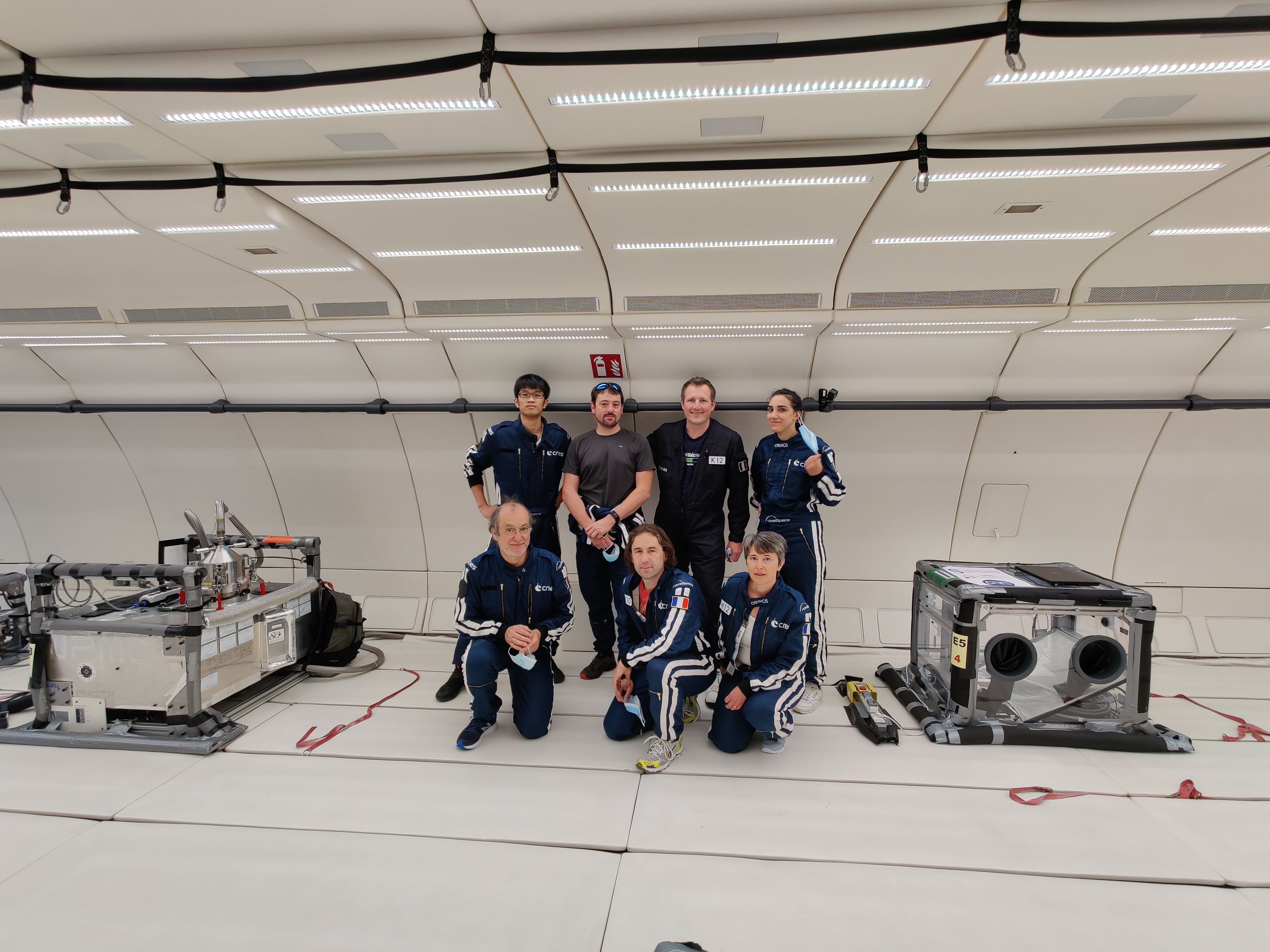
Recent publications and communications
G. Legros and J.L. Torero. Phenomenological model of soot production inside a non‐buoyant laminar diffusion flame. Proceedings of The Combustion Institute, 35:2545-2553, 2015. [link].
G. Jomaas, J.L. Torero, C. Eigenbrod, J. Niehaus, S.L. Olson, P.V. Ferkul, G. Legros, C. Fernandez-Pello, A.J. Cowlard, S. Rouvreau, N.N. Smirnov, O. Fujita, J.S. T'ien, G.A. Ruff, and D.L. Urban. Fire Safety in Space - Beyond Flammability Testing of Small Samples. Acta Astronautica, 109:208-216, 2015. [link].
R. Raffegeau. Quand la NASA joue avec le feu. Science et Vie Junior (Juin 2016) 46–49 [link].
J.-M. Citerne, H. Dutilleul, K. Kizawa, M. Nagachi, O. Fujita, M. Kikuchi, G. Jomaas, S. Rouvreau, J.L. Torero, and G. Legros. Fire safety in space - Investigating flame spread interaction over wires. Acta Astronautica, 126:500-509, 2016. [link]
R. Prud'homme, G. Legros, and J.L Torero. Combustion in microgravity: The French contribution. Comptes Rendus Mécanique, 345:86-98, 2017. [link].
M. Nagachi, F. Mitsui, J.M. Citerne, H. Dutilleul, A. Guibaud, G. Jomaas, G. Legros, N. Hashimoto, O. Fujita. Can a spreading flame over electric wire insulation in concurrent flow achieve steady propagation in microgravity? Proceedings of The Combustion Institute, 37:4155-4162, 2019. [link].
A. Guibaud, J.M.Citerne, J.M. Orlac'h, O. Fujita, J.-L. Consalvi, J.L. Torero, G. Legros. Broadband Modulated Absorption/Emission technique to probe sooting flames: implementation, validation, and limitations. Proceedings of The Combustion Institute, 37:3959-3966, 2019. [link].
D.L. Urban, P. Ferkul, S. Olson, G.A. Ruff, J. Easton, J.S. T'ien, Y.-T. T. Liao, C. Li, A.C. Fernandez-Pello, J.L. Torero, G. Legros, C. Eigenbrod, N. Smirnov, O. Fujita, S. Rouvreau, B. Toth, G. Jomaas. Flame Spread: Effects of Microgravity and Scale. Combustion & Flame, 199:168-182, 2019. [link].
M. Nagachi, F. Mitsui, J.-M. Citerne, H. Dutilleul, A. Guibaud, G. Jomaas, G. Legros, N. Hashimoto, and O. Fujita,
Effect of ignition condition on the extinction limit for opposed flame spread over electrical wires in microgravity,
Fire Technology , 56:149-168, 2020.[link].
A. Guibaud, J.-L. Consalvi, J.-M. Orlac’h, J.-M. Citerne, and G. Legros
Soot production and radiative heat transfer in opposed flame spread over a polyethylene insulated wire in microgravity,
Fire Technology ,56:287-314, 2020. [link].
A. Guibaud, J.-M. Citerne, J.-L. Consalvi, O. Fujita, J.L. Torero, and G. Legros
Experimental evaluation of flame radiative feedback: methodology and application to opposed flame spread over coated wires in microgravity,
Fire Technology , 56:185-207, 2020. [link].
A. Guibaud, J.-M. Citerne, J.-L. Consalvi, and G. Legros
On the effects of opposed flow conditions on non-buoyant flames spreading over polyethylene-coated wires - Part 1: spread rate and soot production,
Combustion & Flame, 221:168-182, 2020. [link]
A. Guibaud, J.-M. Citerne, J.-L. Consalvi, and G. Legros
On the effects of opposed flow conditions on non-buoyant flames spreading over polyethylene-coated wires - Part 2: soot oxidation quenching and smoke release,
Combustion & Flame, 221:544-551, 2020. [link]
A. Guibaud, J.-M. Citerne, J.-L. Consalvi, and G. Legros
Pressure Effects on the Soot Production and Radiative Heat Transfer of Non-Buoyant Laminar Diffusion Flames Spreading in Opposed Flow over Insulated Wires,
Combustion & Flame, 222:530-543, 2020. [link]
J.-L. Consalvi, A. Guibaud, A. Coimbra, J.-M. Citerne, and G. Legros
Effects of oxygen depletion on soot production, emission and radiative heat transfer in opposed-flow flame spreading over insulated wire in microgravity,
Combustion & Flame, 230:111447, 2021. [link]
M. Nagachi, J.-M. Citerne, H. Dutilleul, A. Guibaud, G. Jomaas, G. Legros, N. Hashimoto, and O. Fujita
Effect of Ambient Pressure on the Extinction Limit for Opposed Flame Spread over an Electrical Wire in Microgravity,
Proceedings of The Combustion Institute , 38:4767-4774, 2021. [link]
A. Guibaud, J.-M. Citerne, J.-L. Consalvi, J.L. Torero, O. Fujita, M. Kikuchi, P. Ferkul, N. Smirnov, G. Jomaas, B. Töth, S. Rouvreau, and G. Legros
Accessing the soot-related radiative heat feedback in a flame spreading in microgravity: optical designs and associated limitations,
Proceedings of The Combustion Institute , 38:4805-4814, 2021.[link]
TV show 'Carnets de vol' about parabolic flights in general and our experiment DIAMONDS more specifically
Rationales
For several decades, many sound scientific works on fire growth and the movement of smoke and heat have been providing the engineers with the information and tools that are necessary in the design of fire detection and the definition of the subsequent procedures. However, due to the specific conditions encountered in spacecraft, the usual tools for normal gravity fire detection design needs to be at least assessed into realistic space conditions and probably modified according to the discrepancies among detection thresholds in 1g and 0g, that could lead to unappropriate procedures, then disasters, following a misdetection -or a non-detection- in microgravity.
As a result, NASA launched the SAFFIRE (SpAcecraFt FIRe safety Experiment) project five years ago. This project allows for a close collaboration among American, European, Japanese, and Russian partners gathered in an international topical team. Within the framework of this project, fires are to spread over samples of real length scale (~1m) within real time scale (~20 minutes) into six actual spacecrafts, i.e. Cygnus supply vehicles. These extraordinary experiments are a worldwide première to date into the challenging Mission To Mars. While the results are still processed, the first experiment operated in June 2016 was really successful [link].
Concomitantly, JAXA launched the FLARE (Flammability Limit At REduced gravity) project (see the official sticker below). This project aims at the definition of the conditions that systematically lead to flame extinction within the context of manned spacecraft. The aforementioned international topical team also takes part in the FLARE project.
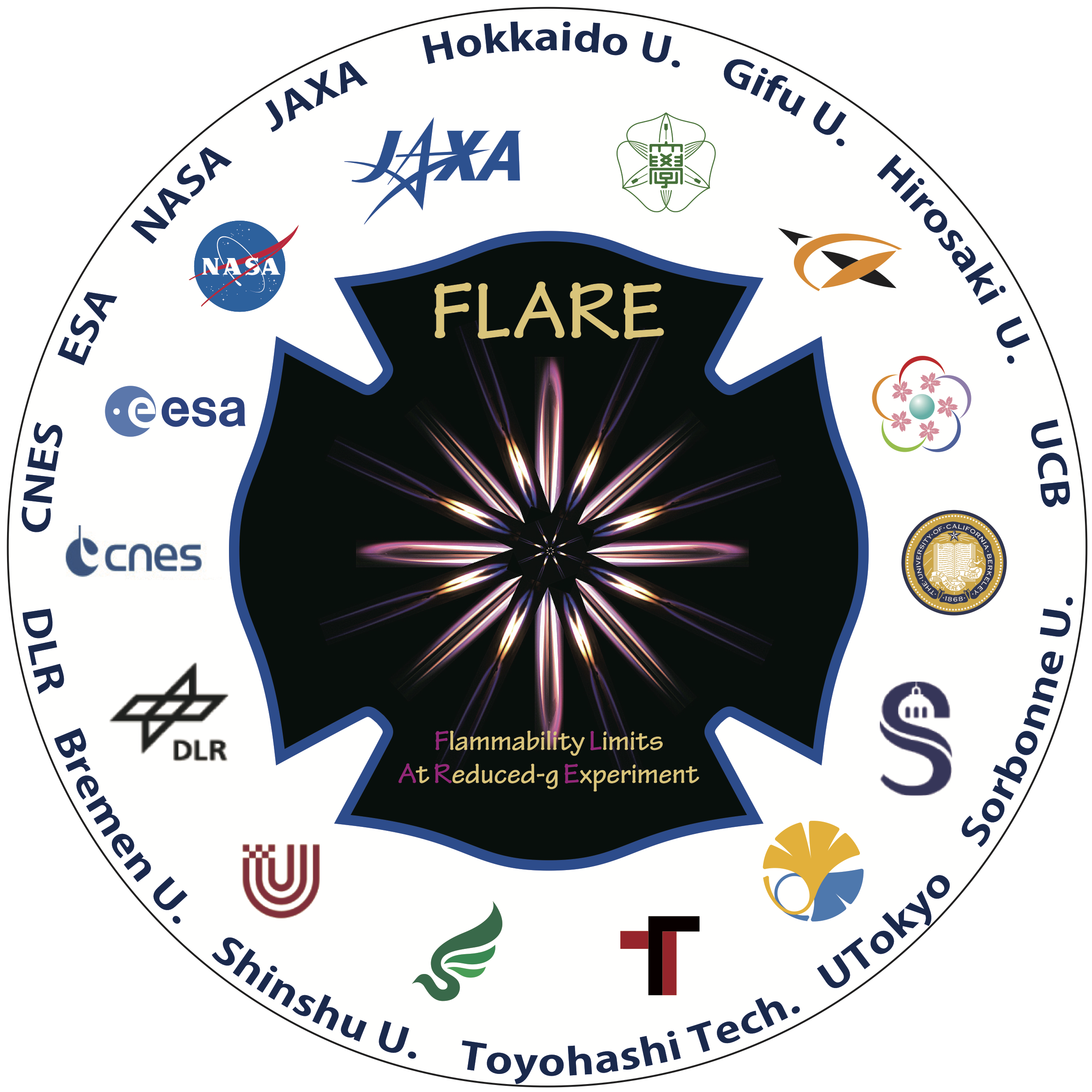
Figure 1: Official sticker of the FLARE project.
The experiments conducted at ∂'Alembert contribute to these international projects.
Works at ∂'Alembert
A rig called DIAMONDS (Detection of Ignition and Adaptive Mitigation Onboard for Non-Damaged Spacecrafts) [link] has been custom-designed at ∂'Alembert to enable the study of flame spreading over the coating of cylindrical wires in microgravity obtained through parabolic flights. This configuration of flame spread is one of those that the FLARE project investigates more specifically.
The schematic shown in Fig.1 introduces the combustion chamber that allows for the strict confinement of the flame spreading over a set of wires.
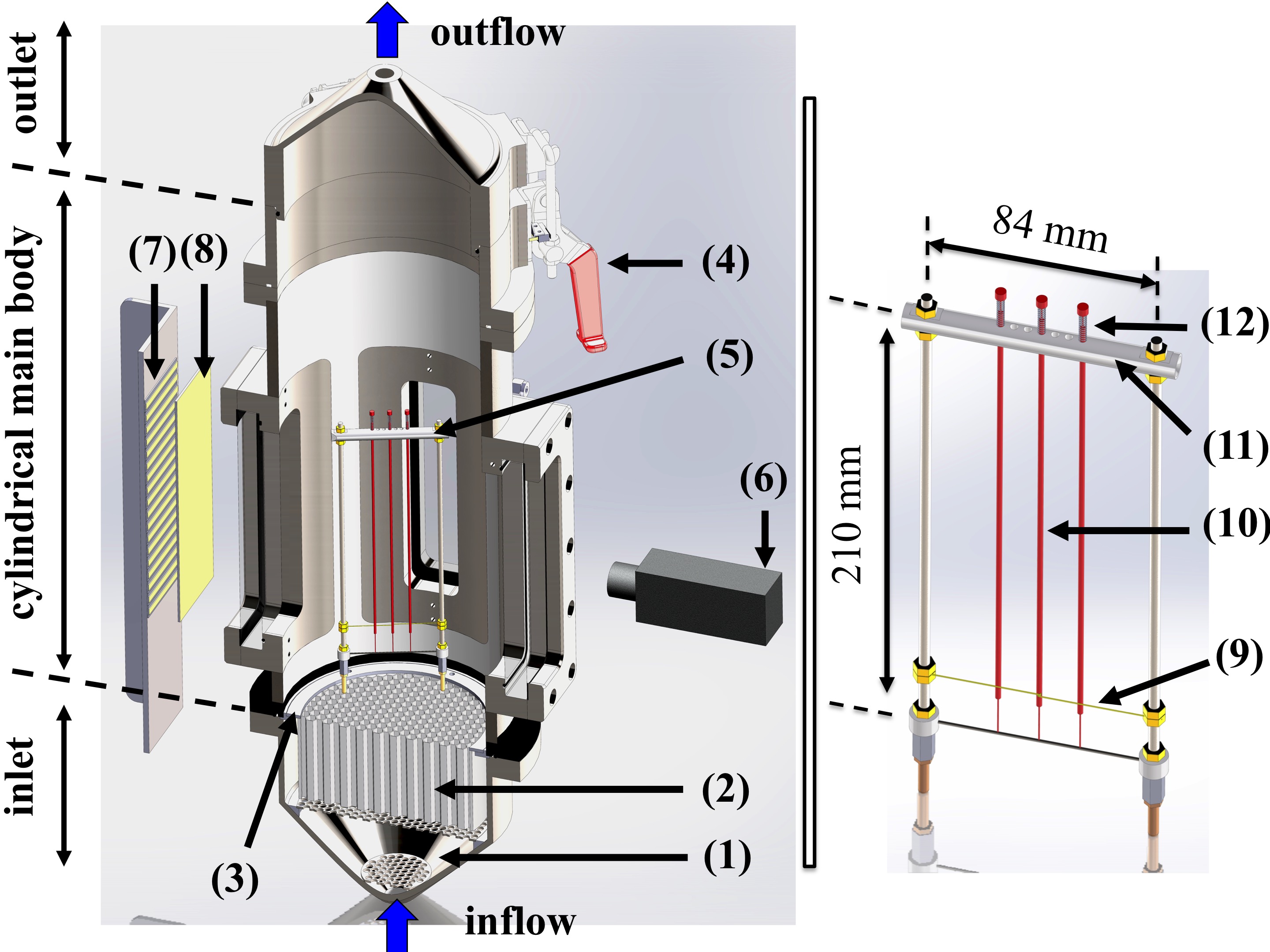
Figure 2: On the left, schematic of the combustion chamber designed for the parabolic flights. (1) Conical part filled with glass beads; (2) stainless steel hon- eycomb; (3) stainless steel ring; (4) latch clamp for top end locking; (5) sample holder; (6) camera; (7) set of LEDs; (8) diffusive screen. On the right, schematic of the sample holder (5) enabling the 3-wire configuration. (9) Kanthal wire; (10) polyethylene coated wire; (11) 10 mm diameter machinable ceramic rod; (12) stainless steel spring.
Figure 2 displays a sequence of frames recorded by the camera (6) capturing the backlight provided by the LEDs (7), as shown in Fig.1. Due to the angle between the line-of-sight of the camera and the normal to the plane containing the 3 wires, a distortion arose and was amplified with the streamwise coordinate, z, as shown by the slope of the white dotted lines in Fig.2. To delay the ignition of the central wire coating, four and five wraps of igniting wire (see (9) in Fig.1) were made around the central wire and the lateral ones, respectively. During the ignition procedure (5 s), the energy deposited was about 20% lower on the central wire than on the lateral ones. As a result, the spread over the central wire's coating was delayed, as shown on the frame captured at t=4.35s.
Two opposite trends may be revealed due to the potential interaction among these flame spreads. The reduced energy deposited on the central wire coating and the oxygen dilution by the combustion products released by the lateral flames would tend to magnify the initial spread delay. Contrarily, the preheating of the central wire coating by the heat released by the lateral flames may accelerate the central spread. As shown by the sequence of frames in Fig.2, the latter effect governs the interaction of spreads in microgravity for the conditions established.
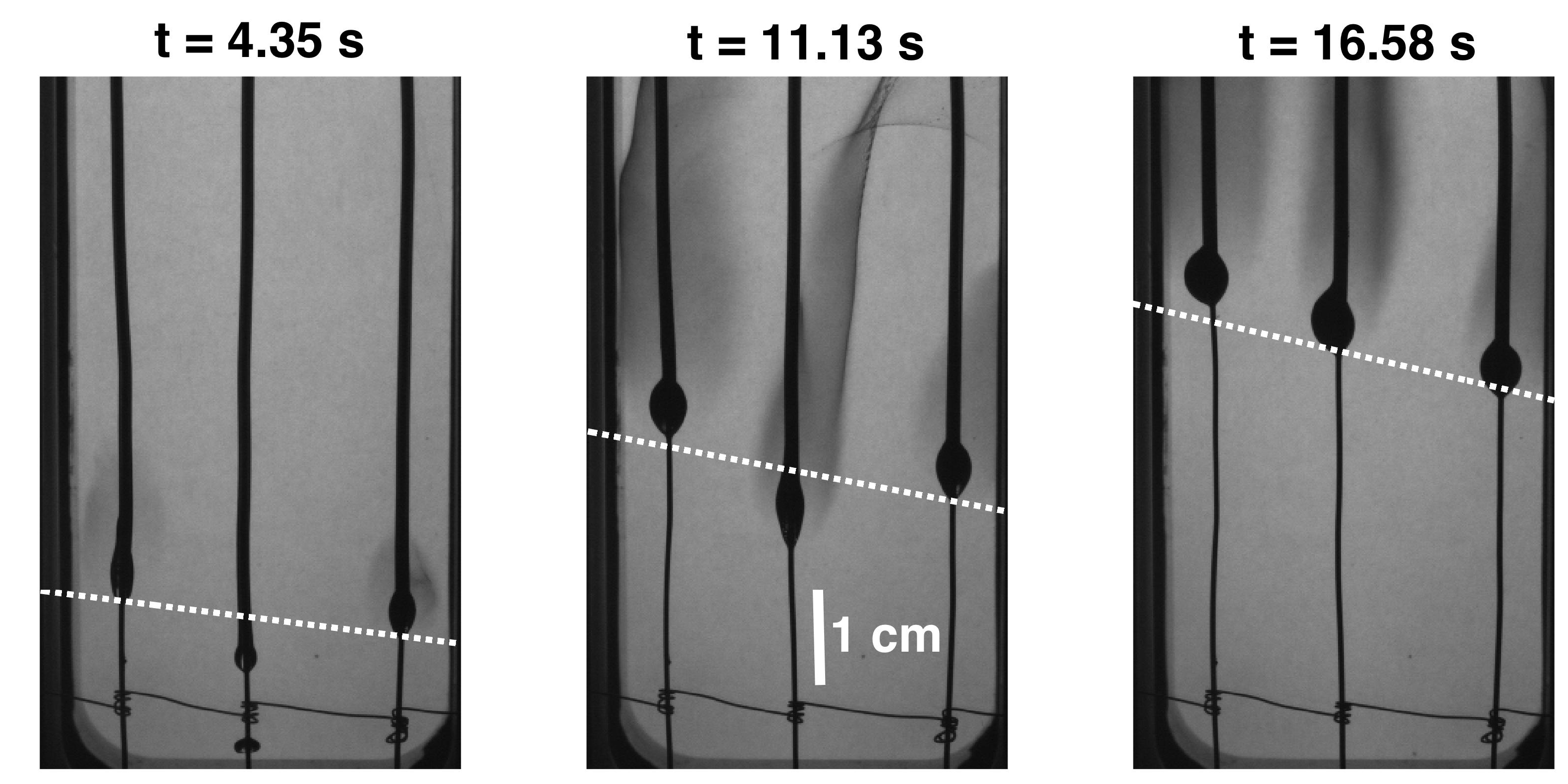
Figure 3: sequence of frames recorded along the concomitant spreads over three wires in microgravity. The oxidizer flows from the bottom to the top. t=0 is the time when the first wire ignition can be detected. The white dotted lines indicate the location of iso-streamwise coordinate z. The delay between the lateral ignitions and the central one is about 4 s. Click on the picture to watch at the movie of this experiment.
Identical conditions could then be established on ground at normal gravity. The central spread could never catch up with the lateral ones. Although a further theoretical analysis is now required, one can decently speculate that the upward convection at normal gravity magnified due to the fact that buoyancy can partially sweep away the heat released by the lateral flames, and thereby weaken the preheating of the coating. Conversely, in microgravity, radiative transfer - partially directed to the coating - is amplified, especially due to increased residence times in flames and enhanced soot production. As a result, spreading flames established in microgravity may interact at longer length scales that at normal gravity.
Prospects
Within the context of Augustin Guibaud's PhD defended in Octember 2019, we started focusing on the assessment of the conditions that can lead to the extinction of a steady flame spread over 1 wire. This especially requires:
- the experimental evaluation of the local emission rate in the flame, i.e. both soot temperature and volume fraction. To this end, we intend to set up a diagnostics inpired by our Modulated Absorption/Emission technique developped around the ∂'Alembert's laminar coflow axisymmetric burner [link];
- numerical developments to help understand the governing phenomena leading to extinction. This will be conducted in close collaboration with Dr Jean-Louis Consalvi (IUSTI, Marseille, France).
Follow here the story of the rig DIAMONDS (Detection of Ignition and Adaptive Mitigation Onboard for Non-Damaged Spacecrafts) for parabolic flights funded by the French Space Agency (CNES).
The UPMC rig flew for the first time on October, 7th - 9th 2014. Click on the picture below to see the flying team.
See here for more specific details about this parabolic flight campaign or read the full story of the UPMC rig below.
Step 1 November 2012 - October 2013
In close collaboration with Brian Verthier (Novespace), Jean-Marie Citerne is designing the new rig at the lab. This procedure namely incorporates structural computations to comply with the safety constraints onboard the zeroG airplane.
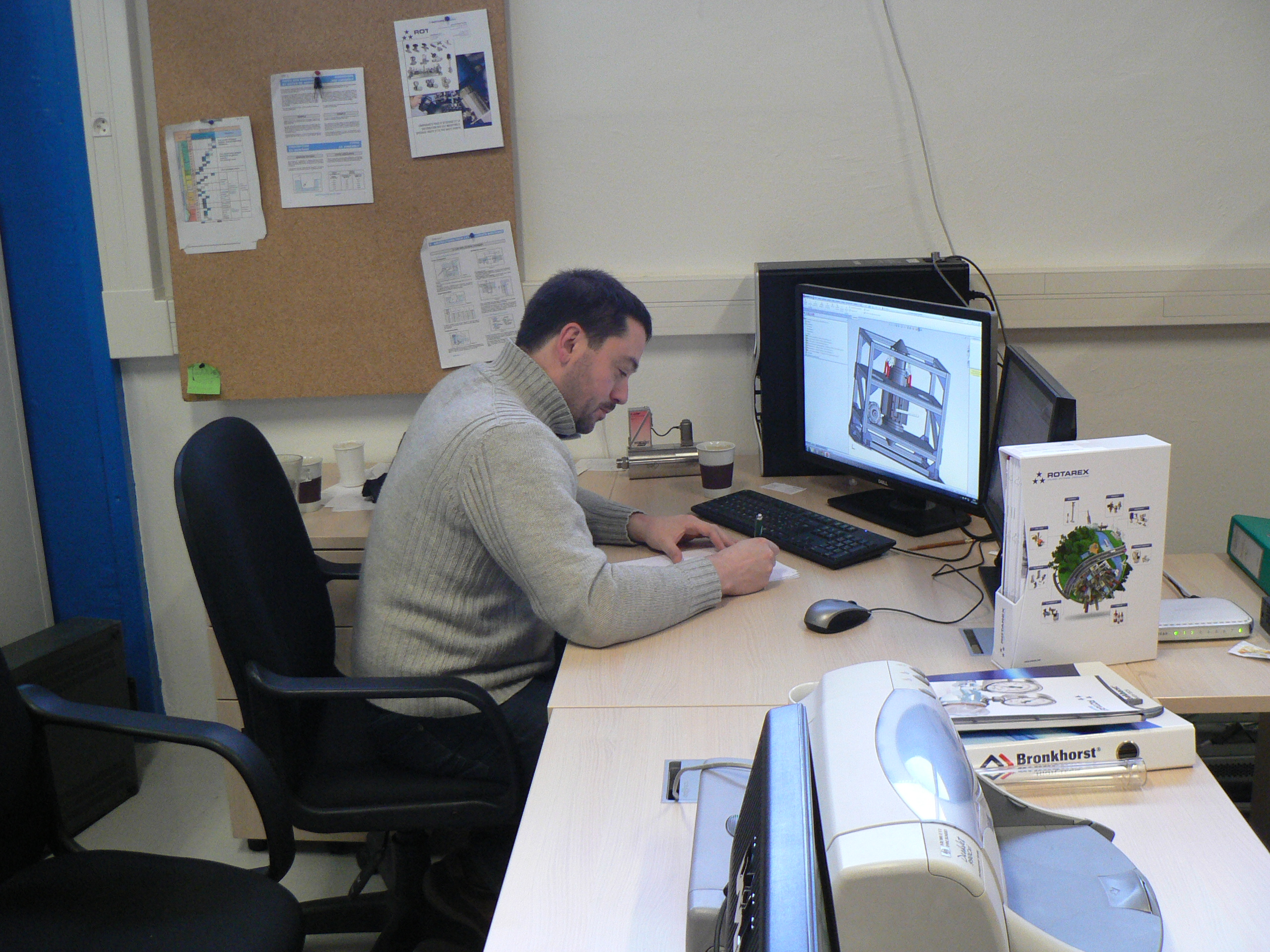
Board with the experiment here.
Have a look at the brand new combustion chamber here.
Step 2 November 2013
We received the combustion chamber (see in the lower left corner) especially designed for the parabolic flights.
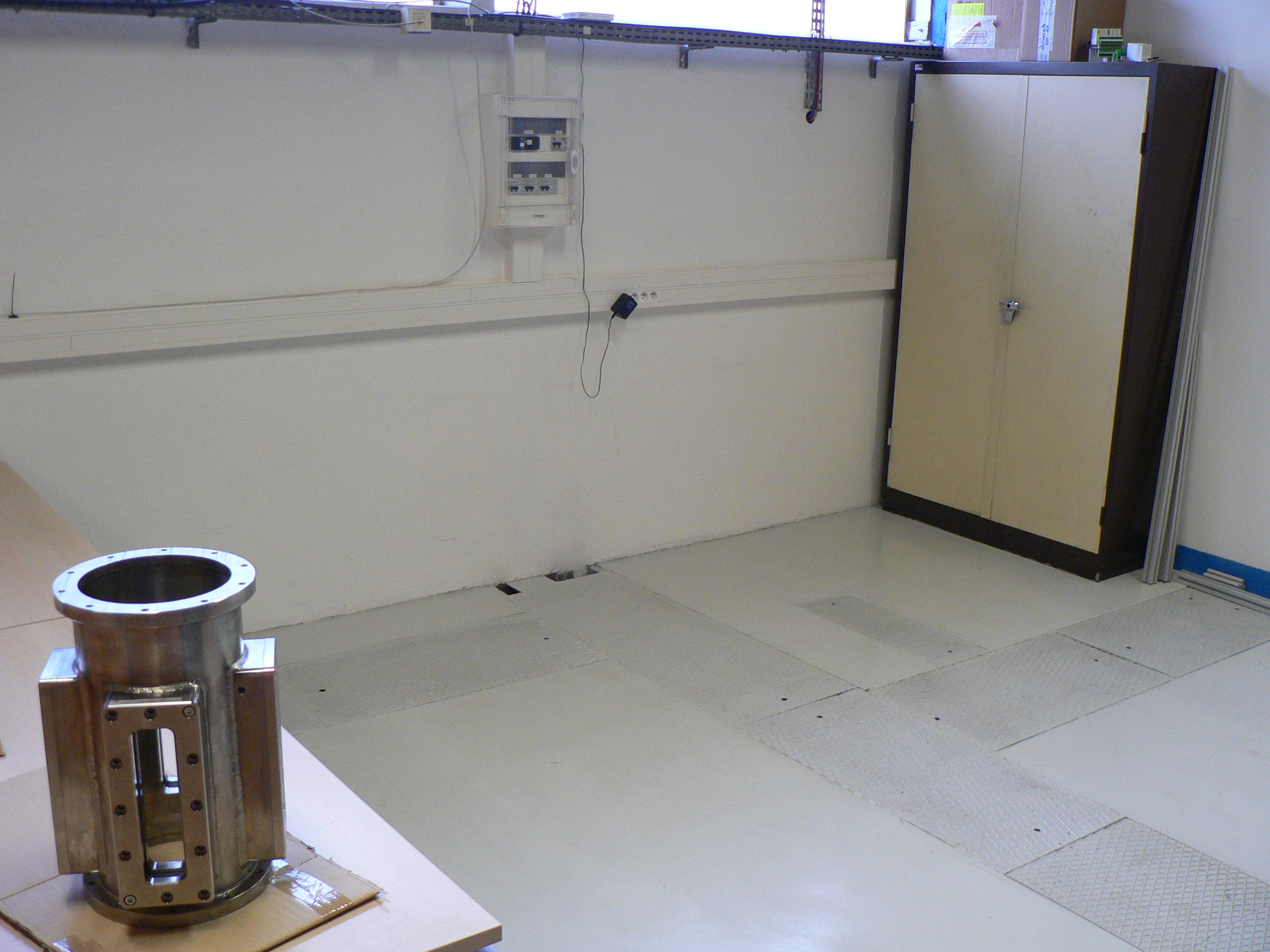
Step 3 December 2013
We start mounting the rig. On the table, you can see the rig where the bottles of gases will be inserted. This rig is dedicated to the preparation of the stream that will flow through the combustion chamber.
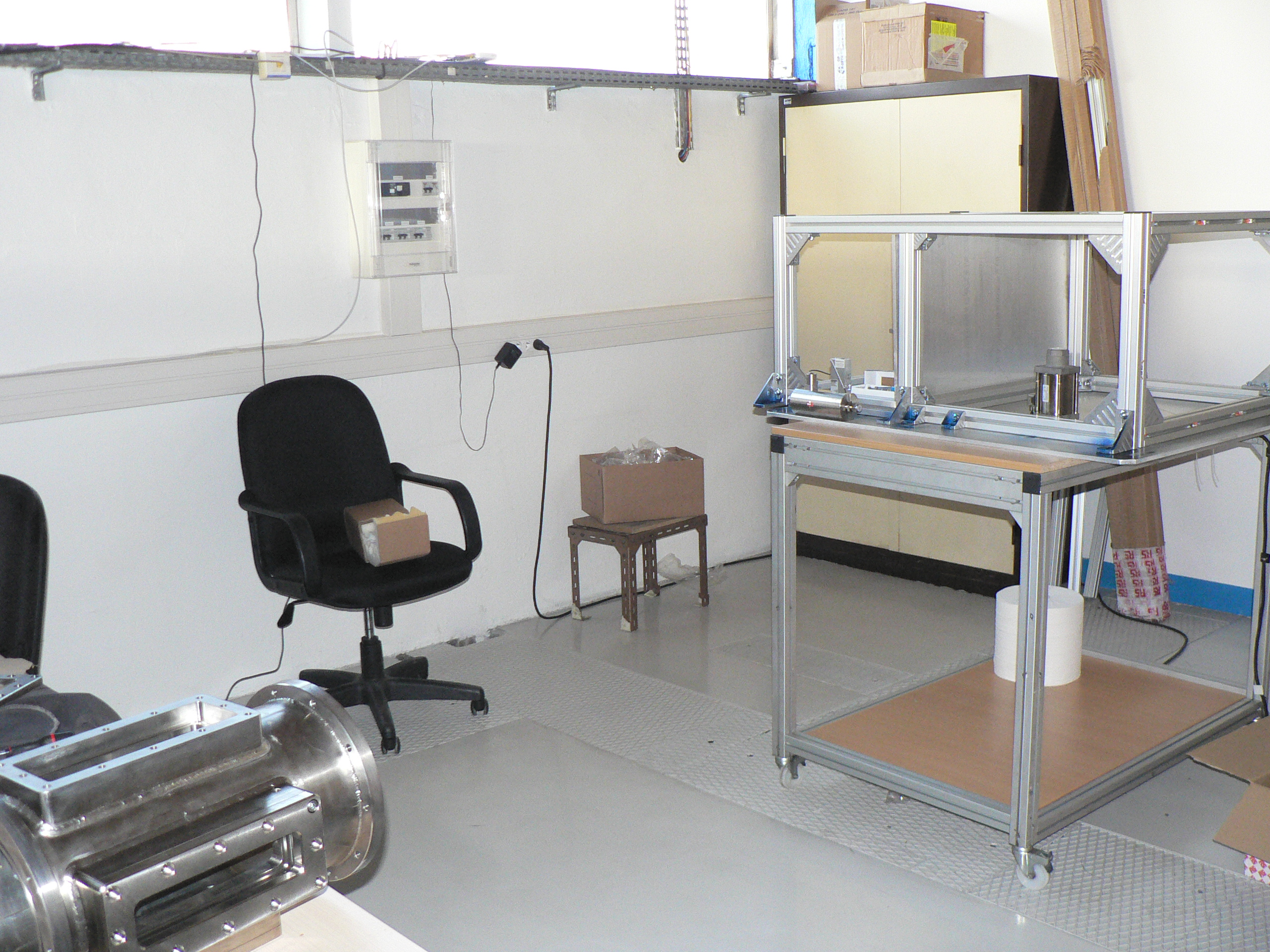
Look at the movie to see Jean-Marie Citerne and Guillaume Legros mounting the rig, after Jean-Philippe Chauvet has cut the beams: here
Hugo Dutilleul designed a small wire holder. This will help design the ultimate ignition system that will enable the study of the flame spread over electrical wires in microgravity, in collaboration with Prof. Osamu Fujita (Univ. Hokkaïdo, Japan). Look at the movie of the first ignition experiment here.
Hugo is making the bottles' holder.
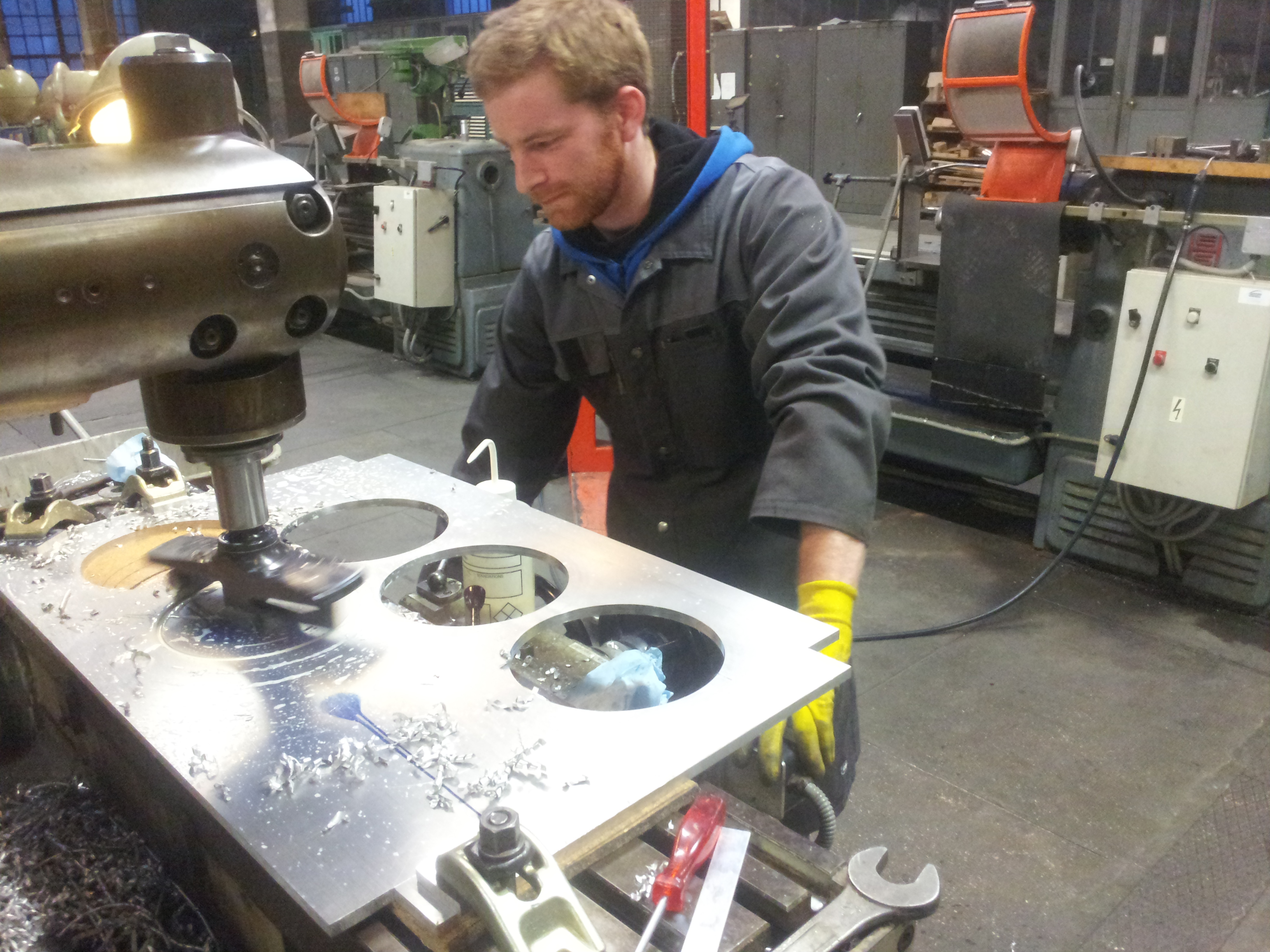
Step 4 January 2014
The rack dedicated to the preparation of oxidizer flow is now operational.
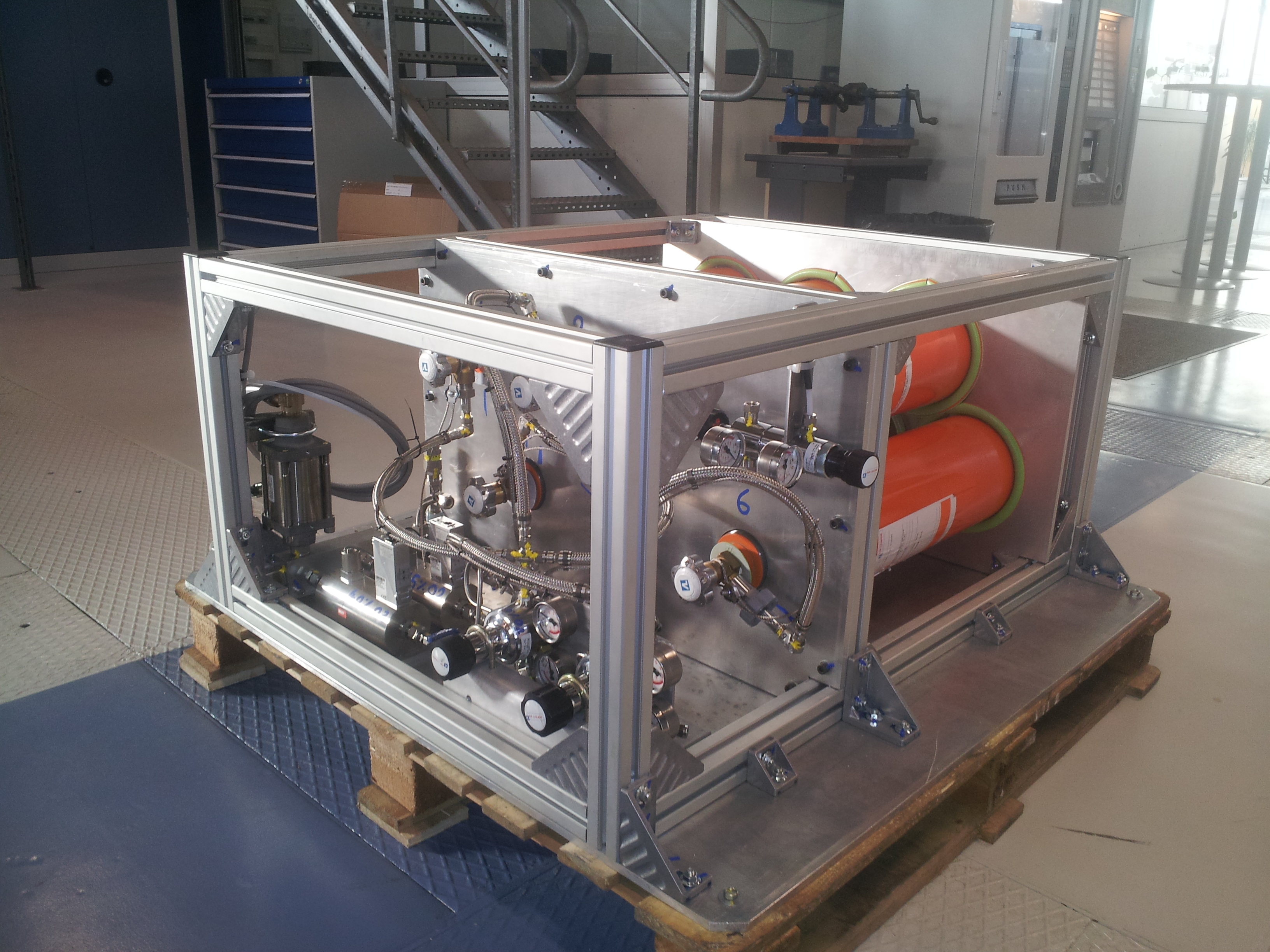
After it has been assembled, the combustion chamber is now incorporated into its specific rack. The chamber especially had to be certified for a given working overpressure.

Step 5 February / March 2014
Along the final experiments on ground, a mechanical failure located at the inlet of the combustion chamber happened. We had to cancel our participation to ESA parabolic flight campaign, scheduled in April.
After few days of depression, we designed a tougher solution. Sébastien Rouquette, CNES Parabolic Flight technical coordinator, expertised the solution to evaluate the step that needed to be bridged. He supported financially and technically the improvements.
Step 6 April / May 2014
Incorporation of the new inlet of the combustion chamber. This inlet has been designed to allow disassembling, cleaning, and re-assembling between 2 flights.
The following pictures captured from the combustion chamber outlet show the different layers that compose the new inlet.
At the inlet of the conical part, a stainless steel grid.

The conical part is then filled with ceramic balls that will make the oxidizer inflow quiescent.
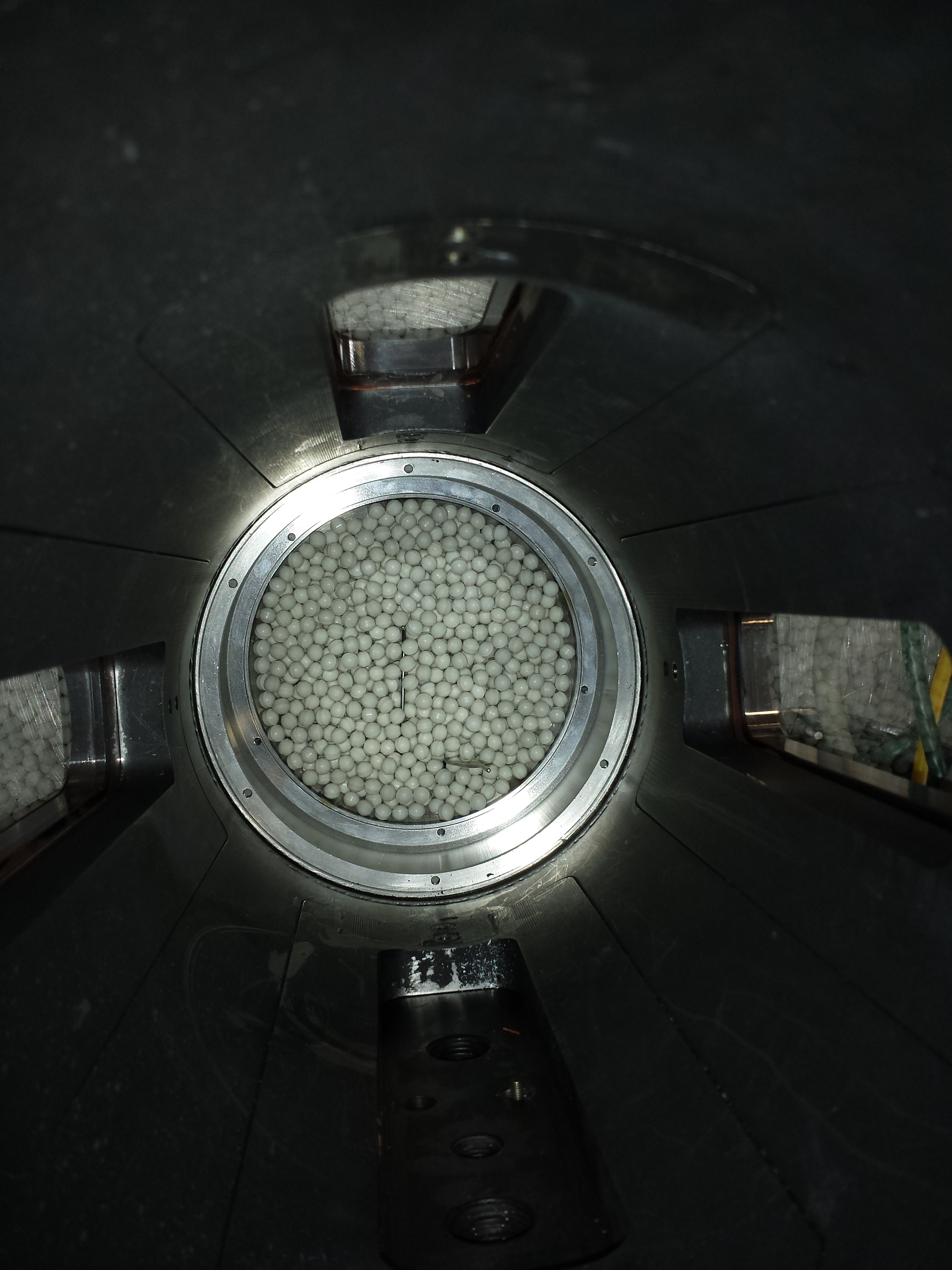
A second stainless steel grid is then screwed to the chamber walls.
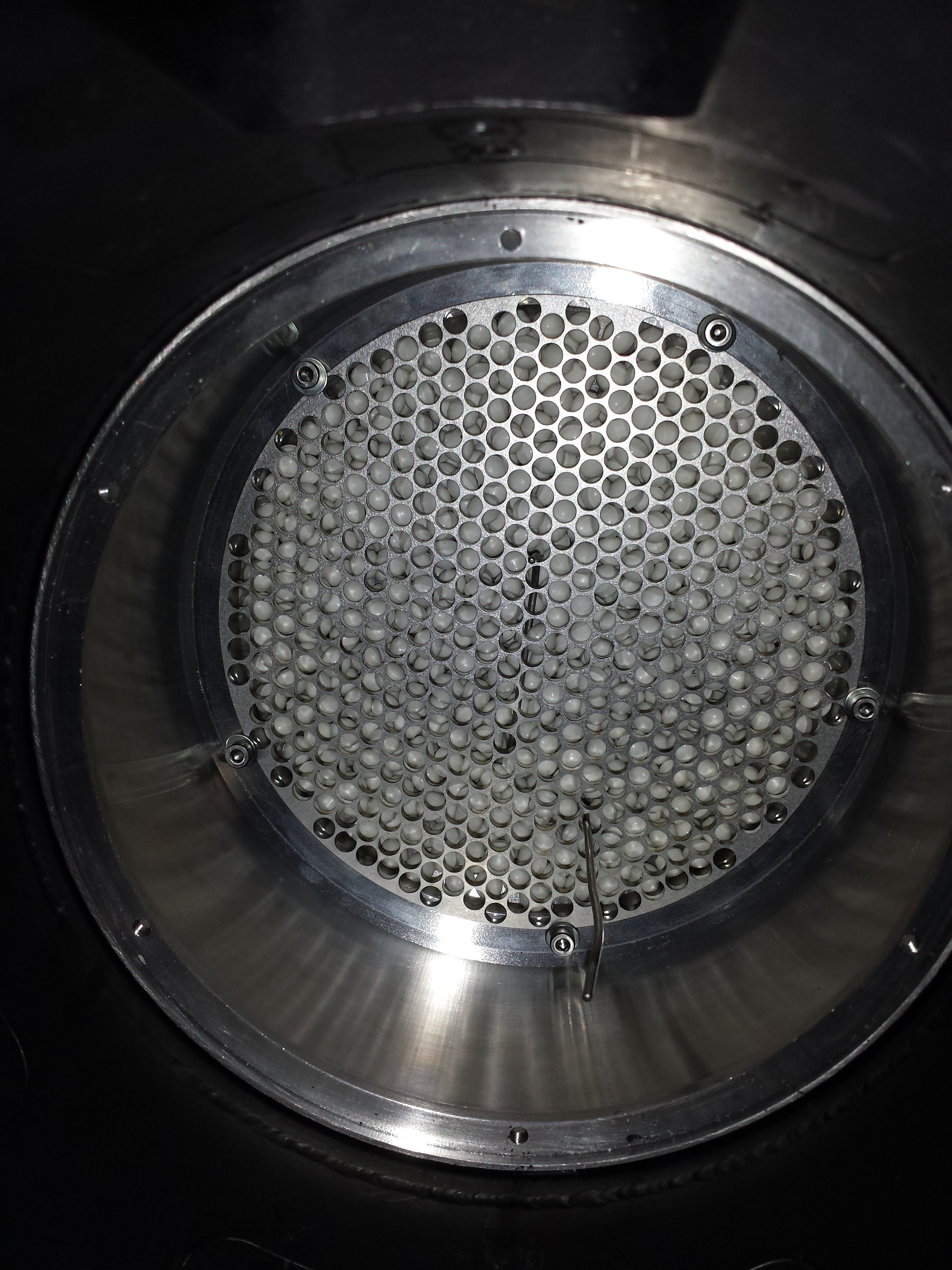
A stainless steel honeycomb will eventually straighten the oxidizer streamlines.
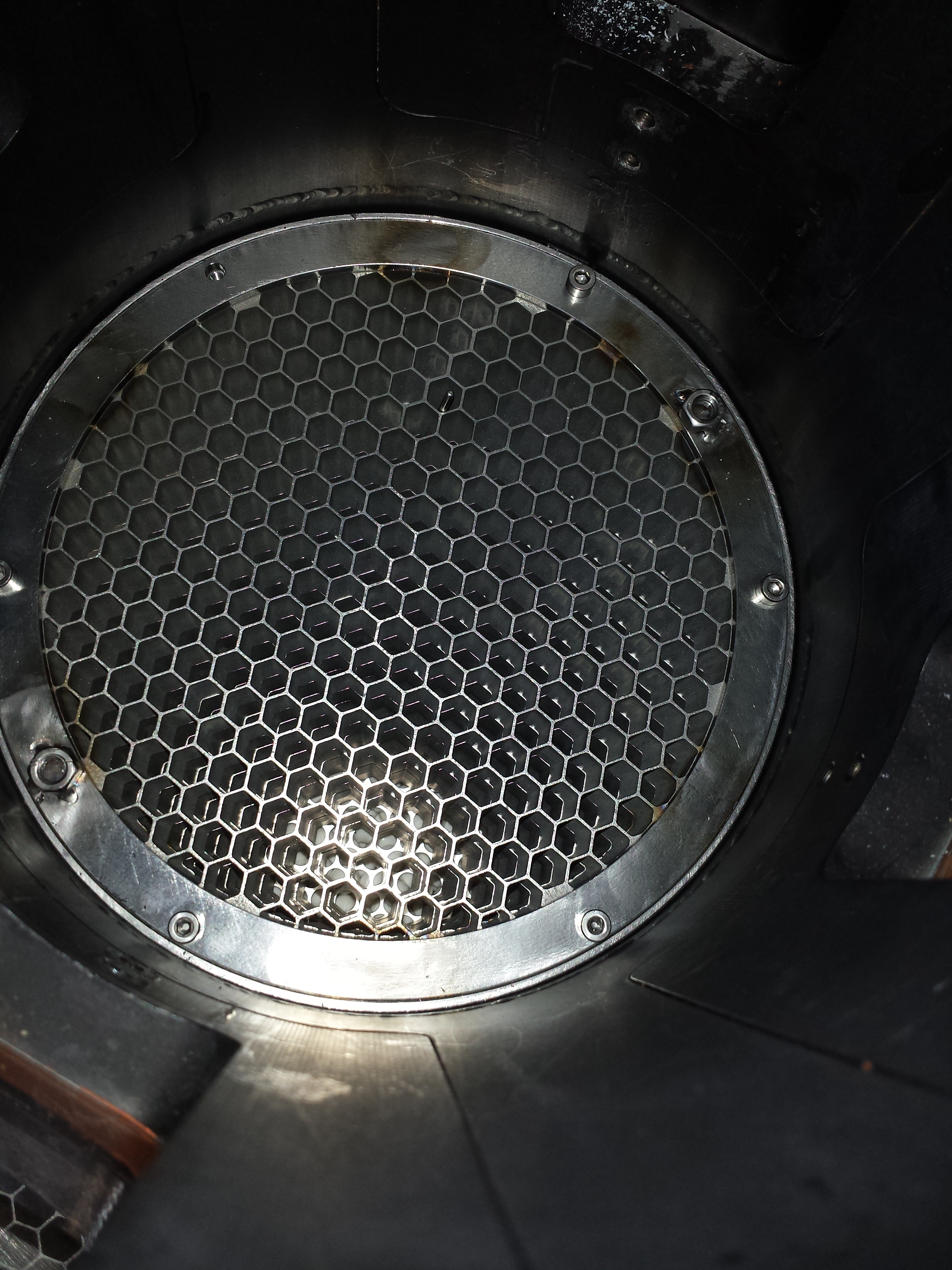
Step 7 June 2014
Design of the sample holder
Getting ready for a collaboration with Prof Osamu Fujita (Univ. Hokkaïdo, Japan), we designed a sample holder made of stainless steel and ceramic. Our CNC machine allowed 35 sample holders to be made.
Here is a sample holder that enables the 3 vertical wires to be mounted. Their polyethylene coating will be ignited with the thin horizontal wire wrapped around.

Step 8 July 2014
Validation of the experimental procedures
Assigned by Sébastien Rouquette, Christian Chauveau, Directeur de Recherche at CNRS, headed a committee that validated the rig and its associated operational procedures.
Look at one of the 31 tests conducted to mimic on ground -therefore with buoyancy- 1 flight. We burnt here the coatings of the 3 wires shown above. The air stream flows upwards. The coating is ignited at the top of the coating at the beginning of the movie. On the left, you can see the shadow of the coatings that are consumed. In the middle, you can see the frames provided by another camera capturing the visible flame. Here, the optical diagnostics settings still need to be optimized.
Step 9 September 2014
Getting ready for the coming parabolic flight campaign
Strengthened by all the steps we had to face, we adjusted the diagnostics settings to make sure that the first campaign will deliver preliminary but significant results. Jacques Baillargeat, engineer at CNRS (Poitiers), especially designed an electronic device allowing the cameras to be synchronized.
Sent by Prof Fujita, Koki Kizawa, student in master degree, joined us for a month. At the end of September, the rig is ready to leave to Bordeaux.
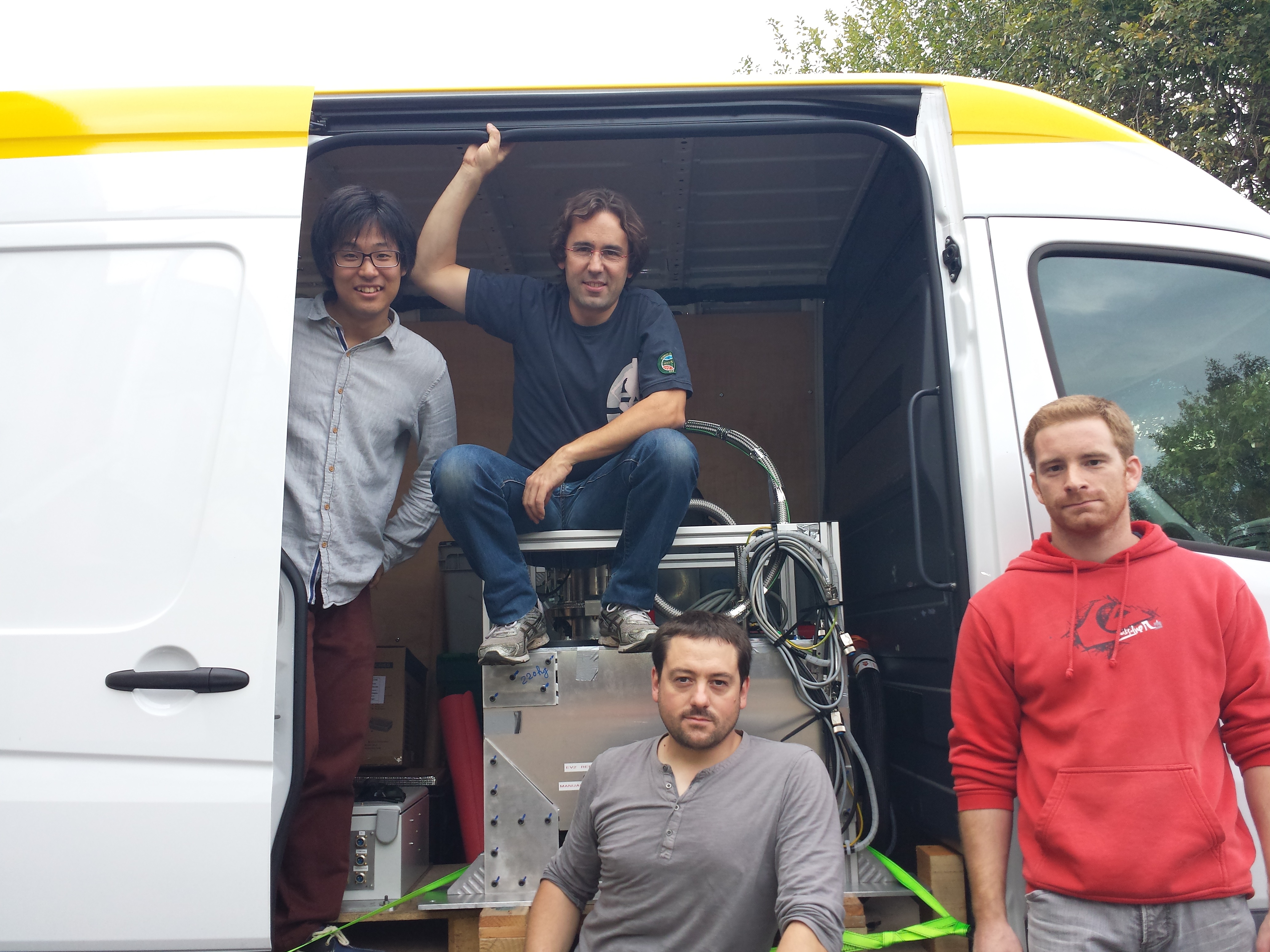
Step 10 Septembre / October 2014
CNES VP 112: first parabolic flights campaign for the rig.
This campaign was the very beginning of an expected collaboration between CNES and JAXA that was especially initiated by Bernard Zappoli (CNES).
The experiments were conducted by the international team surrounding the rig aboard the airplane A300 zeroG. From the left to the right: K. Kizawa (Hokkaïdo Univ., Japan), G. Jomaas (DTU, Denmark), G. Legros (UPMC), O. Fujita (Hokkaïdo Univ., Japan), M. Kikuchi (JAXA, Japan), J.-M. Citerne (UPMC), H. Dutilleul (UPMC).
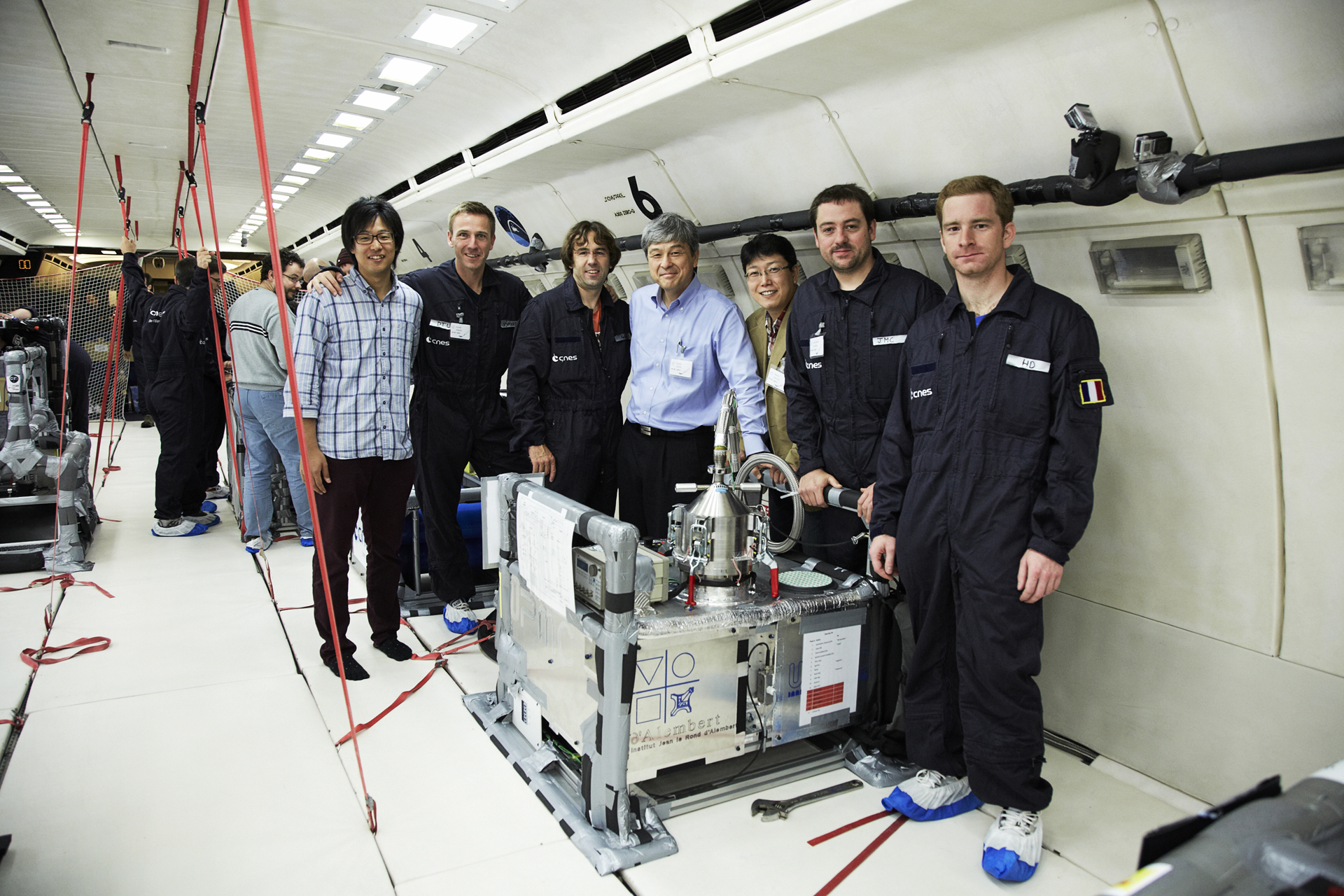
After a final check by Brian Verthier (Novespace), the rig is certified: it will fly.
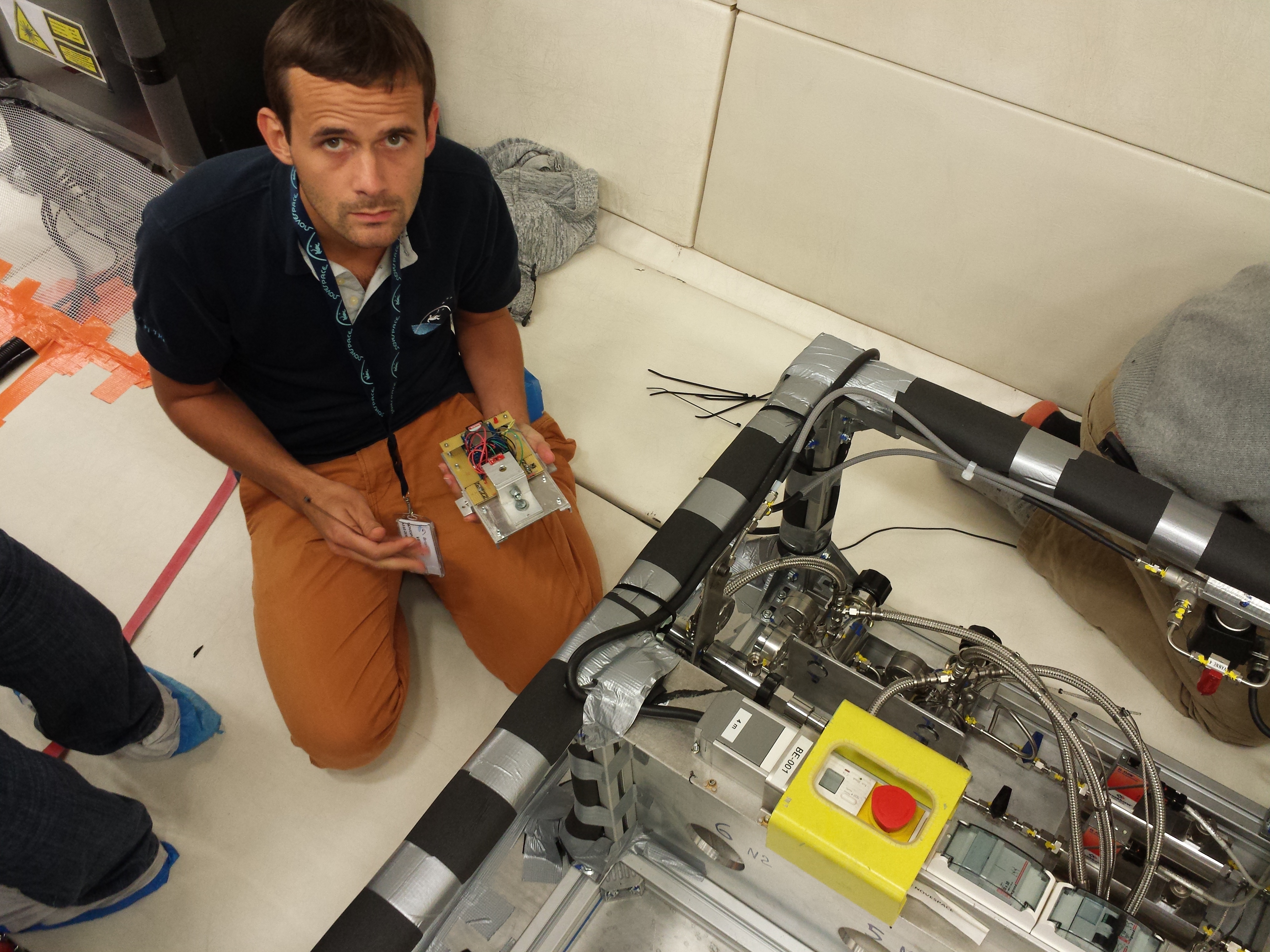
Now watch the movie by Søren Kristensen, the Danish journalist who recorded the cabin at the time of our first successful flame spread in microgravity over a cylindrical sample:
Have also a look at one of the first successful parabola:
We burnt here a coating of polyethylene surrounding a metallic wire. The air stream flows upwards. The coating is ignited by a Kantal wire that heats up the bottom of the coating at the beginning of the movie. On the left, you can see the shadow of the wire that is consumed in microgravity, together with the soot produced in the flame plume. In the middle, you can see the frames provided by another camera capturing the visible flame.
On the 2nd day, we conducted for the 1st time experiments to study the interaction among propagations over the same kind of samples. Here is a movie reporting an interesting one
We burnt here three coatings. The air stream flows upwards, i.e. in the direction of the spread. The coatings on the sides are ignited before the one in the middle. Supported by the radiative heat transfer from the surrounding spreads, the spread over the central wire is accelerated and the flame can catch up the other ones before final extinction due to a nitrogen flush.
That is a kind of weightless team...

Step 11 October 2014
Back at home
Leaving the plane, Jean-Marie and the rig are waiting in the line for the van.

Exhausted but at home! Yet, we still have to unload the rig...
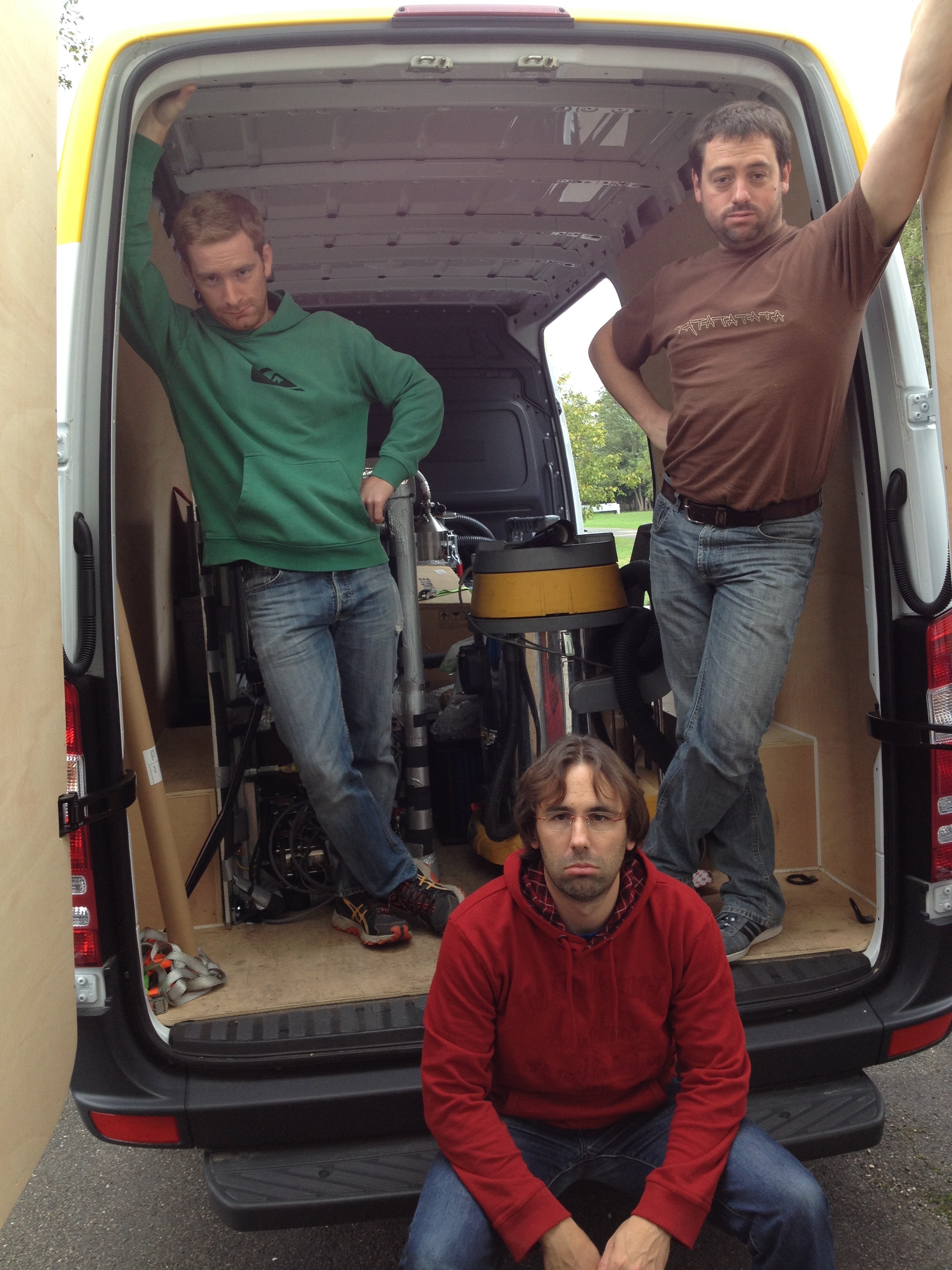
Determined, we did it!

Step 12 2015 ???
"I want more flights !!!" (Koki Kizawa, onboard the plane during the ultimate flight of VP 112 campaign)
- Détails
- Écrit par legros
- Catégorie : Articles exemples
- Affichages : 3971
Follow here the studies that aim at the magnetic control of combustion characteristics.
This project is a collaboration with Pr H. Pitsch and Pr. T. Gomez.
Recent related publications:
G. Legros, T. Gomez, M. Fessard, T. Gouache, T. Ader, P. Guibert, P. Sagaut, and J.L. Torero. Magnetically induced flame flickering.Proceedings of The Combustion Institute, 33:1095–1103, 2011 [link].
A. Jocher, H. Pitsch, T. Gomez, and G. Legros. Modification of sooting tendency by magnetic effects. Proceedings of The Combustion Institute, 35:889–895, 2015 [link].
A. Jocher, J. Bonnety, H. Pitsch, T. Gomez, and G. Legros. Dual magnetic effects on soot production in partially premixed flames. Proceedings of The Combustion Institute, 36:1377–1385, 2017 [link].
A. Jocher, H. Pitsch, T. Gomez, and G. Legros. Combustion instability mitigation by magnetic fields. Physical Review E, 95:063113, 2017 [link].
A. Jocher, J. Bonnety, T. Gomez, H. Pitsch, and G. Legros. Magnetic control of flame stability: application to oxygen-enriched and carbon dioxide-diluted sooting flames. Proceedings of The Combustion Institute, 37:5637-5644, 2019 [link].
Rationales
The growing concerns about increasing energy demand, energy efficiency policies, energy security issues, hazardous effects of combustion-related emissions on human health, and global warming change have led to more and more stringent regulations on exhaust emissions from combustion devices, and especially on soot release.
Standard strategies of soot production control involve post-treatment methods, such as filters and/or catalysts. However, using in situ strategies looks like an increasingly promising method. Examples are the design of new fuels, addition of exhaust gases to the combustion process, or combustion control by electrical fields. Interestingly, none of these strategies utilises magnetic fields.
Among the species contributing to the combustion process, O2 and OH exhibit relatively high paramagnetic susceptibilities. Yet the magnetic force acting on this kind of species per unit volume can be expressed as follows:

where χi is the species magnetic susceptibility per unit mass, Yi its local mass fraction, ρ the local density, μ0 the vacuum magnetic permeability, and B the magnetic flux density. In the follwoing, the gradient of B2 is referred to as magnetic gradient. As a result, in the presence of a non-uniform B field, one can then expect the additional magnetic force to play a role in selective transport phenomena. In addition, O2 and OH are considered as highly soot-oxidzing species. For this reason, we have investigated the influence of magnetic fields in sooting flames for a few years.
Works at ∂'Alembert
The configuration of the burner is the so-called Santoro one. This is a laminar axisymmetric coflow burner that is largely documented in the literature related to soot production. The pictures shown in Fig.1 introduce the experimental setup that has been developed at Inst. ∂'Alembert to allow the investigations to be conducted.
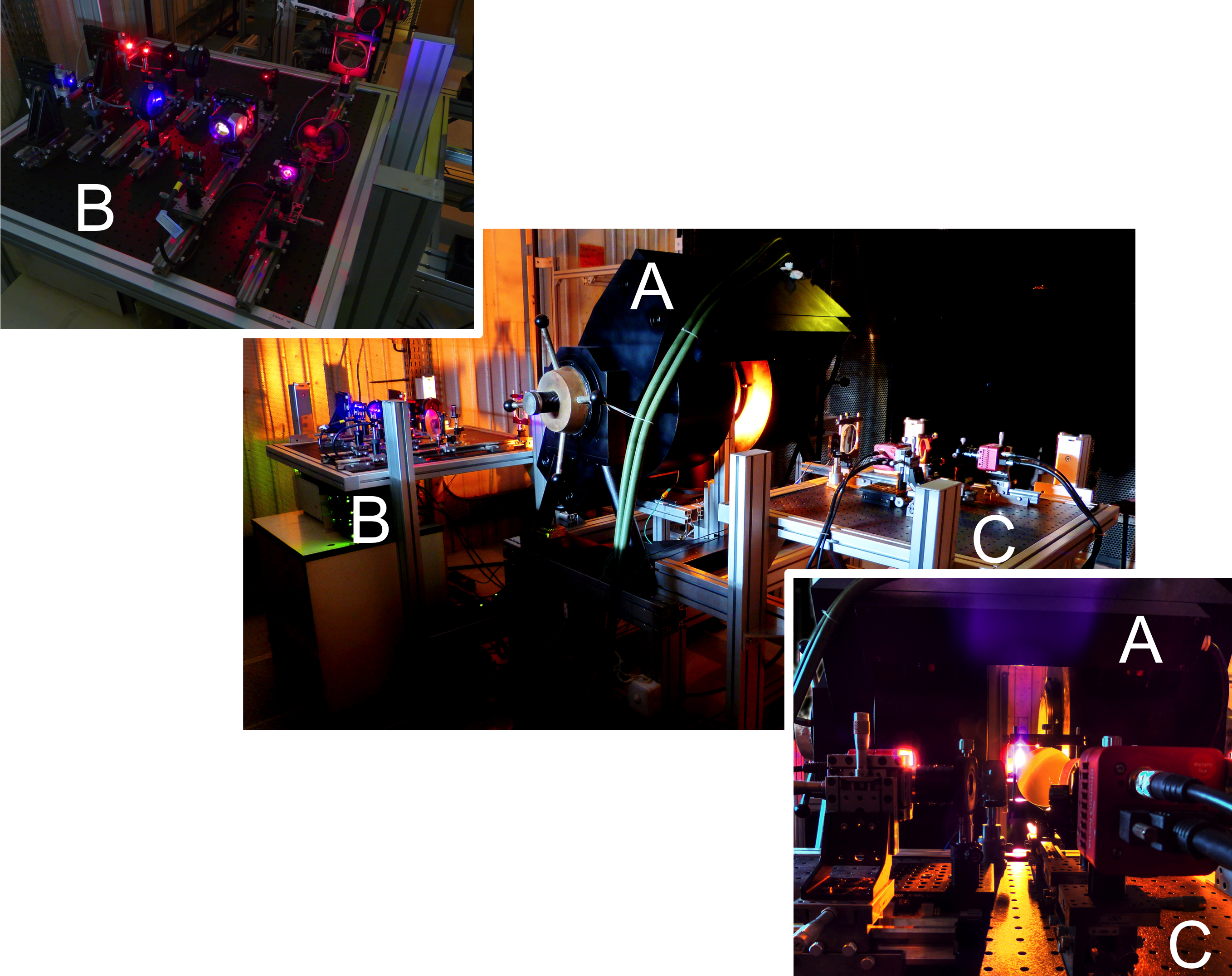
Figure 1: experimental arrangement for the investigations on the influence of magnetic fields on sooting flames. A: electro-magnet; B: emission optics enabling the Modulated Absorption/Emission technique; C: collection optics. The inserts in the upper left and lower right corners show close-up views on B and C, respectively. The flame established over the Santoro axisymmetric coflow burner can be seen in the background of the insert in the lower right corner.
For the results presented here, the fuel stream, consisting of pure ethylene (C2H4), flows through the vertical axial brass duct, which has an effective diameter of injection of 11 mm. The coflowing oxidizer mixture is introduced into a concentric brass cylinder of 102 mm inner diameter. The oxidizer consists of a O2 and N2 mixture. Two mass flow controllers enable the variation of the oxygen molar content, XO2, in the oxidizer stream. Over the range of investigated flow rates, both fuel and oxidizer flows are steady and laminar at the height of the burner tip. In order to expose the flames to fairly uniform upward magnetic gradient, the burner tip is located 0.13 m below the coils axis of symmetry (see Fig.1). The magnitude of the magnetic gradient can be adjusted from 0 to 18.2 T2/m when setting the DC electrical current I that flows through the turns that constitute each coil.
Within the context of these works, the soot temperature and volume fraction fields are mapped by the Modulated Absorption/Emission (MAE) technique, that has been specifically developped at ∂'Alembert for two-dimensional axisymmetric flames. Figure 1 shows the optical arrangement (B) to deliver two collimated laser beams at two different wavelengths. These beams will cross the flame and the altered beams will be collected on two cameras (C). The absorption of every beam can then be evaluated, which is deconvoluted to yield the local soot volume fraction field. In addition, the local spectral emission rates can be inferred from the flame's emission at both wavelengths. The ratio of both spectral emission rates yield the local temperature field throughout the flame provided that soot is present. Thus, mapping soot temperature with MAE does not require any model correlating soot volume fraction and local spectral absorption coefficient. Only the measurements of the latter at two different wavelengths are required to enable the self-calibration of the technique and infer soot temperature from the ratio of the local spectral emission rates. Thus, the issue of the large discrepancies in the wavelength-dependent soot refractive index reported in the literature does not arise.
Figure 2 illustrates how the magnitude of the magnetic gradient can influence the soot production in the non-premixed flame where ethylene burns in air. As the magnitude of the upward magnetic gradient is increased, the raw extinction coefficient, which represents the optical density along the line-of-sight of the red laser beam, also increases, showing that more soot is produced in the flame. We showed that increasing the magnetic gradient monotonically actually enhances soot production for every oxygen content of the coflow in these non-premixed flames.
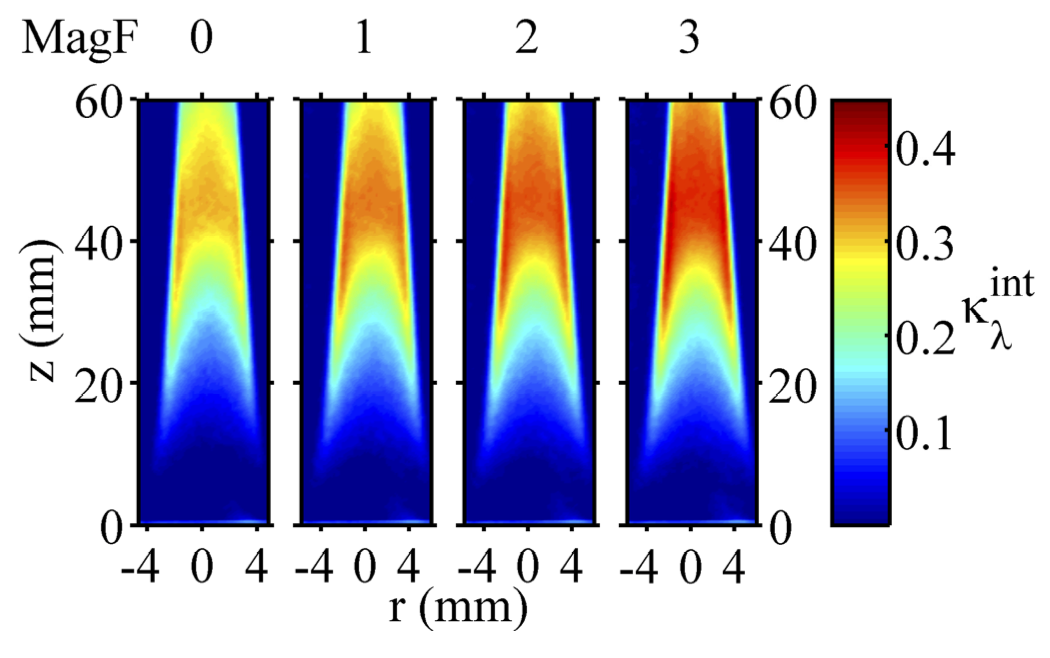
Figure 2: Maps of the raw integrated extinction coefficient measured with the red (645 nm) laser beam for increasing magnitude of the upward magnetic gradient, starting from 0 (MagF 0) to 18.2 T2/m (MagF 3). The ethylene non-premixed flame burns here in air. z=0 is the location of the burner tip.
To understand this observation, we can manipulate the formulation of the aforementioned magnetic force per unit mass. Due to the linear dependency on the species mass fraction, one can attribute the major contribution of the magnetic force to O2. This then leads to the following expression of the magnetic force:

where the superscript (∞) indicates the conditions away from the flame. This latter expression looks very similar to the formulation of the buoyant force below:
![]()
g being the gravitational acceleration.
Thus, the presence of a magnetic gradient can initiate and sustain a so-called thermo-magneto convection, which is here opposed to buoyancy as the magnetic gradient points upwards. For relatively long flames, buoyancy plays an important role. However with increasing magnetic gradient, the thermo-magneto convection is enhanced. Consequently the global residence time inside the flame is increased with increasing magnitude of the magnetic gradient. As a result, soot formation which exhibits a relatively long charateristic time is promoted.
Interestingly, similar trends have been reported in non-buoyant non-premixed sooting flames, which further supports the above reasoning about the balance between buoyancy and thermo-magneto convection.
Prospects
In the literature, one can find evidences of close correlations between soot production and flame stability. In the coming months, we will investigate the potential of the magnetic effects to influence the stability domain of flames.

